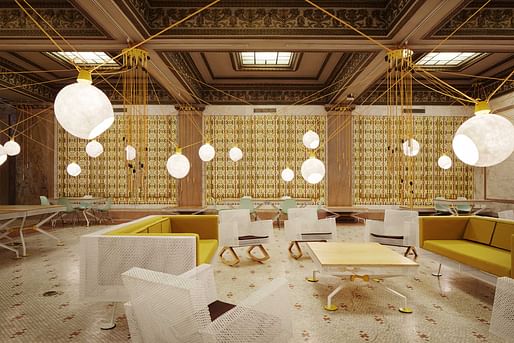

Mexico City-based designers Ana Paula Ruiz Galindo and Mecky Reuss, professionally identified as Pedro y Juana, have perhaps one of the most visited exhibitions in the entire Chicago Architecture Biennial. Their installation – a network of hanging paper lanterns on pulleys, accompanied by custom-designed tables and chairs – strategically furnishes the entirety of the Chicago Cultural Center’s Randolph Square, also known as “the living room of the city.”
Randolph Square is the main entrance foyer of the Cultural Center, where people come to linger regardless of exhibitions happening inside. As such, Pedro y Juana’s installation had to be ready for use, relatively hardy, and manage traffic flowing in and out of the Center. Their coordinated wire-mesh rocking chairs, sofas and tables became an easy complement to the heavily marbled Beaux-Arts interior, providing a much needed space for reflection, resting and discussion throughout the Biennial.

The lighting system serves more of a social purpose than anything, as visitors tested the limits of the pulley’s strength or pulled a lantern towards them to show a friend.
But aside from welcoming visitors to the Biennial, such an installation aligns with Pedro y Juana’s experimentation with the creation of social spaces. The duo has been putting on Sesiones Puerquitos (Little Pig Sessions), which they describe as “a format for conversation that we have been experimenting with. It includes a Caja China, a piglet, people, some time and/or/not a series of topics with changing locations.” No piglets in Randolph Square yet, but the Biennale doesn’t close until January 3.
No Comments
Block this user
Are you sure you want to block this user and hide all related comments throughout the site?
Archinect
This is your first comment on Archinect. Your comment will be visible once approved.